|
Author
|
Topic: Wind
|
M. C. Rowley
|
 posted January 25, 2005 06:37 PM
posted January 25, 2005 06:37 PM


I am having a difficult time comprehending the reason why wind flows near the surface at roughly 20 degrees inward of isobars around lows and roughly 20 degrees outward from highs and then flows essentially parallel to contours at higher altitudes. I assume this change is due to friction at the earth's surface, however, at first glance one would think that wind should flow more perpendicular to pressure contours. Since this is obviously not the case, what is the driving force that makes wind flow parallel to contours. Is the Coriolis force entirely responsible for this? Can you direct me to a resource that explains this mathematically? I understand the concept of pressure gradients and that highs normally have weaker winds due to centripetal forces increasing much faster than the Coriolis force. This explains the reduced pressure gradient normally found around highs, however, does not explain why wind flows roughly parallel to isobars.
I look forward to your answer, in the meantime, I will keep reading......Mark
|
|
David Burch
|
 posted January 27, 2005 01:11 PM
posted January 27, 2005 01:11 PM


Mark, i notice from your other post that you have the weather trainer software. If i may direct you to article A2 on What Makes the Wind. Click the book called Wind in the main library page. There are pictures and detailed discussion.
The key is wind flows from High to Low due to the pressure gradient (gravity), and coriolis force bends it to the right (NH). With no friction, it continues to bend until pressure gradient balances out coriolis force and this leaves the wind flowing parallel to the isobars.... and indeed this is what happens at higher elevations where there is no friction.
at the surface, on the other hand, the bend to the right is resisted by the surface friction and the balance of forces occurs before it bends all the way around, leaving it flowing some 15 to 30° out of a High, which is exactly the same as saying into the Low.
The issue of strong winds around Lows and weaker around Highs is another issue. Partly related, as you have detected, but with more nuance. We have actual equations to illustrate this in that same article, see page 20 and 21 region.
From: Starpath, Seattle, WA
|
|
Robert Bemben
|
 posted September 02, 2005 05:33 PM
posted September 02, 2005 05:33 PM


There's an interesting 'twist' to this that I read about in relation to sailing. The wind direction at the foot of the sail is different from the wind direction at the head of the sail, also due to friction of the water surface. That's why some 'twist' is desirable in the mainsail (not just to 'spill wind' in a blow), i.e. the head of the sail is pointed more windward than the foot, because the wind direction there is more windward.
I'm wondering if the Coriolus effect at work here too? I think it applies to both starboard and port tacks.
|
|
David Burch
|
 posted September 03, 2005 08:39 AM
posted September 03, 2005 08:39 AM


You bring up an excellent point here... actually several points. First, yes, the twist in a main, especially in light air, is related to Coriolis effect and to gradient wind and to friction. As covered in several places mentioned above, wind flows from high to low (gradient wind -- stronger the gradient, the stronger the wind) and then the Coriolis effect bends it to the right. In the absence of friction it would bend all the way to the right and run essentially parallel to the isobars describing the local pressure field.
In the presence of the friction the wind experiences near the surface, however, there is a retarding force on this rotation to the right. so the wind does not get to bend as far to the right on the surface (higher friction) as it does at higher elevations (less friction) such as at mast height.
Thus as you go up in elevation form the deck of the boat, several things happen to the wind because of the decrease in friction influence. First as you go up the wind veers (shifts to the right) and at the same time it gets stronger (less friction slowing it down).
The magnitude of these effects can be roughly estimated. The difference between wind flow direction in high friction (such as wind over land) compared to wind over water could be as much as 30 to 50°. Likewise the same gradient over water might make a wind speed of twice that over water. Have you ever came in from sailing in strong winds to go on land and belive that the wind has just died and you quit too early.... or start out on land with a fresh breeze and really find a blow once you get out on the water.
So in a sense we have from no friction to max friction some roughly factor of two in speed and some 40° in direction. The speed factor actually depends a lot on wind speed. at 20 kts the change might be just from 20 to 25 or 30, but at 2 kts it could be from 2 to 4 or 5... ie at high winds maybe 20 percent or so but at low winds a factor or 2 or more. the same effect is responsible for gusts... high winds gust from 20 to 30 say, low winds gust from 2 to 4. it is the same effect. most gusts are just the elevated winds (from the region of less friction) falling to the surface.
Back to the mainsail, top vs bottom. The wind at the top of the main is veered and stronger--but the differences will not be nearly as large as the maximum values just cited. The question you pose is essentially which factor dominates, and it appears the increase in wind speed with elevation is more important than the veer. I say this because the twist in main trim does not as a rule depend on tack (as you noted), whereas the veer factor would change with tack but the speed factor does not. we will look at this more, but should immediately say that this effect is most important in light air since in stronger air the layers are more mixed and the flow is more the same at deck level and mast level. In very light air, again there could be quite a large difference.... and perhaps if one did a careful study in light air, one might detect a difference in trim for opposite tacks, but that is not a common issue.
The common issue is trim the top batten parallel to the boom, for the reason that the apparent wind at the mast head is generally aft of the wind on the deck. We have an extensive section in the weather trainer software program about apparent wind, with numerous examples and a computer for doing it as well as instructions for the graphic solution.
We have several general rules that might help or confuse us in this regard. First, the faster we go, the more the apparent wind shifts forward -- just imagine that you were suddenly going 60 mph... the wind would be straight in your face regardless of where it was coming from when going slow. But this is not the vector diagram of interest here. In wind up the mast case, we are traveling at a fixed speed, and the true wind is higher at the top than on deck, as shown in the figures below. Note then that the apparent wind shifts aft. This effect would be true regardless of tack. Note in the other pictures, that if there were no wind increase and just a veer, we would get different results on opposite tacks....
In the following we have made some examples with the freeware true wind program that we provide to any webcard holder. It is quite a nice little program. Starpath TrueWind.
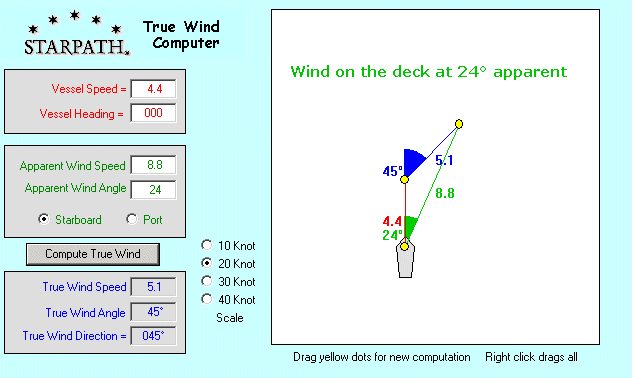
Here we use arbitrary values that might occur. As we go up the mast, the speed increases but all else remains the same (we neglect the veer for the time being), so we end up with the next picture.
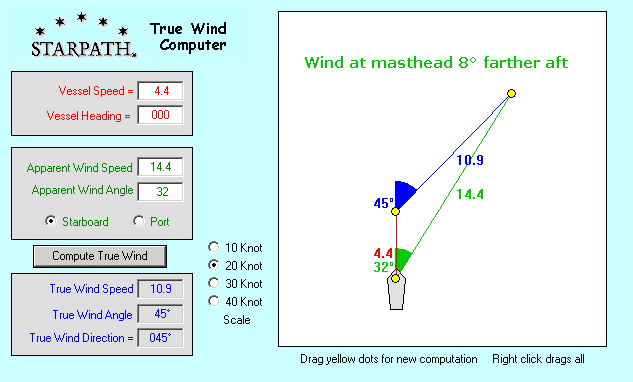
Notice that with nothing but the true wind speed increasing, the apparent wind moves aft. The values here are arbitrary. It is unlikely that an increase would be so large (5 to 10 kts), this is just to emphasize the shift in apparent wind direction.
If the wind aloft is just veered with no increase in speed then the results depend on the tack. Below is the starboard tack example, where we have arbitrarily used a veer of 17° (45 to 62) to get about the same effect as the wind speed increase.

On the port tack however, the same 17° veer gives a dramatically different apparent wind angle, which would call for very different trimming on opposite tacks -- which is not observed, so this must not be taking pplace this way.
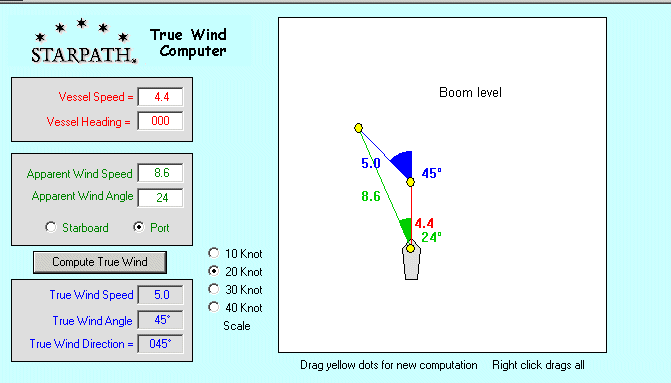
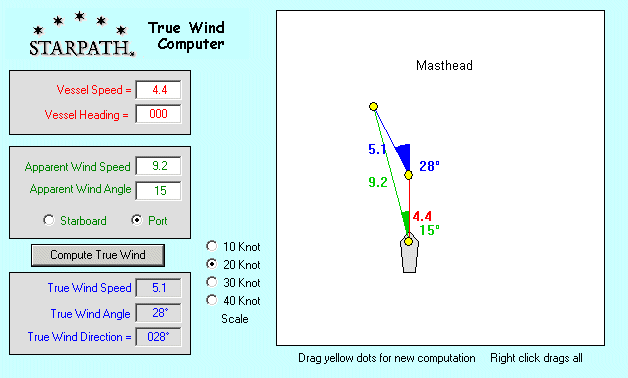
In the final drawings we need to show that for what might be typical light air values, the speed increase will overcome the veer effect on the port tack. The sample below shows a 5° veer with factor of 2 wind speed increase, and we do have the wind going aft about 5°. Starboard tack does not matter since speed and veer cause the same effect on apparent wind -- shift it aft.
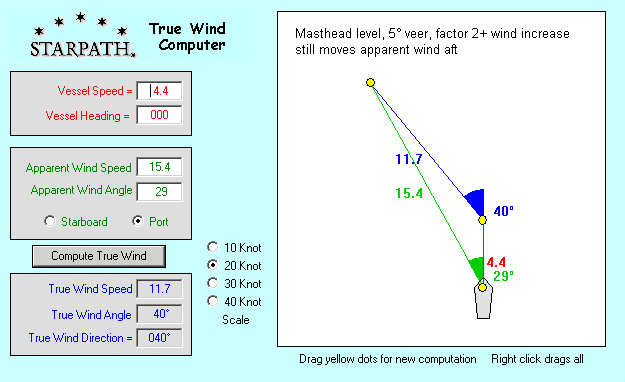
I think we might conclude that the veer factor is low in this first 30 to 80 feet of typical sail boat mast heights, ie that this veer is not likely to be even 5°, and so the dominant factor is the increase in wind speed which forces the apparent wind aft at the masthead relative to that of the boom or mid sail area.
Their certainly is data available for wind speed and direction as a function of elevation that will answer this question unambiguously, but our job will be to find any that is for such low elevations. I am sure it exists. We might start with yacht designers or sailmakers.
From: Starpath, Seattle, WA
|
|
|









